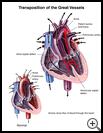
Transposition of the Great Vessels
________________________________________________________________________
KEY POINTS
- Transposition of the great vessels (TGV) means that the positions of the 2 main arteries that carry blood away from the heart are reversed from normal.
- You child may need medicines and surgery to correct the defect. It may be done in stages.
- Your child will need to have regular follow-up visits with a specialist in congenital heart disease. Follow your child’s healthcare provider's instructions for taking care of your child at home.
________________________________________________________________________
What is transposition of the great vessels?
Transposition of the great vessels (TGV) means that the positions of the 2 main arteries that carry blood away from the heart are reversed from normal.
The 2 main arteries of the heart are:
- The pulmonary artery, which carries oxygen-poor blood from the heart to the lungs
- The aorta, the big artery that carries oxygen-rich blood from the heart to the rest of the body
If these arteries are reversed, the blood goes to the lungs, picks up oxygen, returns to the heart, and then flows right back to the lungs without ever going to the body. Blood from the body returns to the heart and goes back to the body without ever picking up oxygen in the lungs.
Babies born with TGV can stay alive only if they have 1 or more other defects that allow the oxygen-poor blood and the oxygen-rich blood to mix until they can have surgery. These defects are:
- A hole between the 2 upper chambers of the heart (atrial septal defect)
- A hole between the 2 lower chambers (ventricular septal defect)
- A blood vessel connecting the lung artery with the aorta (patent ductus arteriosus)
What is the cause?
The cause of this birth defect is not known.
What are the symptoms?
Babies with TGV look blue right after birth. This is because their body is not getting enough oxygen-rich blood.
How is it diagnosed?
This birth defect can be diagnosed before birth. The test that may show the problem is an echocardiogram, which uses sound waves (ultrasound) to show pictures of the heart and how well blood is flowing through it.
Your baby’s provider will examine your child. Tests may include:
- An oxygen monitor on the baby’s hand or foot to measure the blood oxygen level
- An echocardiogram, which uses sound waves (ultrasound) to show pictures of the heart and how well blood is flowing through it
- An ECG (also called an EKG or electrocardiogram), which measures and records your baby’s heartbeat
- Chest X-ray
Sometimes heart catheterization may be needed. A catheter is a very thin tube that is passed through a blood vessel into the heart. The pressure in the chambers of the heart is measured and blood samples can be taken. This helps diagnose a defect and can tell how big the defect is.
How is it treated?
TGV may be treated in stages.
- A medicine may be given for a short time to keep the small blood vessel open between the aorta and the pulmonary artery. This will help the oxygen-poor blood and the oxygen-rich blood to mix.
- Your child may have a procedure that uses a catheter (small tube passed through a blood vessel) to create a hole between the 2 upper chambers of the heart. This will also help the oxygen-poor blood and the oxygen-rich blood to mix.
- Your child will have surgery to correct the problem and allow blood to flow through the heart in the right directions. This is usually done within the first week of life.
Children who have had successful surgery generally lead normal, healthy lives. However, they may still have some heart problems.
How can I take care of my child?
Your child will need to have regular follow-up visits with a specialist in congenital heart disease. Follow your child’s healthcare provider's instructions. Ask your provider:
- How and when you will get your child’s test results
- How long it will take for your child to recover
- If there are activities your child should avoid and when your child can return to normal activities
- How to take care of your child at home
- If your child should take antibiotic medicine to prevent infection before having dental work or procedures that involve the rectum, bladder, or vagina
- What symptoms or problems you should watch for and what to do if your child has them
Make sure you know when your child should come back for a checkup. Keep all appointments for provider visits or tests.
Last modified: 2021-12-07
Last reviewed: 2018-11-26

